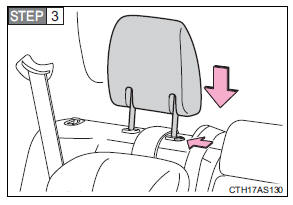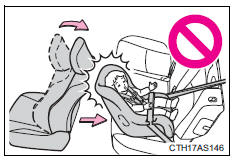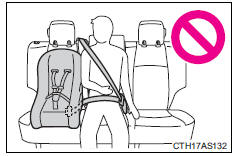Toyota 4Runner: Child restraint systems with a top tether strap

Secure the child restraint system using a seat belt or the lower anchors, and remove the head restraint.

Open the anchor bracket cover, latch the hook onto the anchor bracket and tighten the top tether strap.
Make sure the top tether strap is securely latched.

Replace the head restraint.
Laws and regulations pertaining to anchorages
The LATCH system conforms to FMVSS225 or CMVSS210.2.
Child restraint systems conforming to FMVSS213 or CMVSS213 specifications can be used.
This vehicle is designed to conform to SAE J1819.
CAUTION
When installing a booster seat
To prevent the belt from going into ALR lock mode, do not fully extend the shoulder belt. ALR mode causes the belt to tighten only. This could cause injury or discomfort to the child.
When installing a child restraint system
Follow the directions given in the child restraint system installation manual and fix the child restraint system securely in place.
If the child restraint system is not correctly fixed in place, the child or other passengers may be seriously injured or even killed in the event of sudden braking, sudden swerving or an accident.

• If the driver’s seat interferes with the child restraint system and prevents it from being attached correctly, attach the child restraint system to the righthand rear seat.
• Adjust the front passenger seat so that it does not interfere with the child restraint system.

• Only put a forward-facing child restraint system on the front seat when unavoidable.
When installing a forward-facing child restraint system on the front passenger seat, move the seat as far back as possible even if the “AIR BAG OFF” indicator light is illuminated. Failure to do so may result in death or serious injury if the airbags deploy (inflate).
CAUTION
When installing a child restraint system
• Vehicles with third row seats: When using the LATCH anchors for a child restraint system, move the seat as far back as possible, with the seatback close to the child restraint system.
• When a booster seat is installed, always ensure that the shoulder belt is positioned across the center of the child's shoulder. The belt should be kept away from the child's neck, but not so that it could fall off the child's shoulder. Failure to do so may result in death or serious injury in the event of sudden braking, sudden swerving or an accident.
• Ensure that the belt and plate are securely locked and the seat belt is not twisted.
• Push and pull the child restraint system from side to side and forward to be
sure it is secure.
• After securing a child restraint system, never adjust the seat.
• Follow all installation instructions provided by the child restraint system manufacturer.
CAUTION
Do not use a seat belt extender
If a seat belt extender is used when installing a child restraint system, the seat belt will not securely hold the child restraint system, which could cause death or serious injury to the child or other passengers in the event of sudden braking, sudden swerving or an accident.
To correctly attach a child restraint system to the anchors
• When using the LATCH anchors, be sure that there are no foreign objects around the anchors and that the seat belt is not caught behind the child restraint. Make sure the child restraint system is securely attached, or it may cause death or serious injury to the child or other passengers in the event of sudden braking, sudden swerve or an accident.

• When using the left side LATCH anchors for the child restraint system, do not sit in the center seat. Seat belt function may be impaired, such as being positioned overly high or loosefitting, which may result in death or serious injury in the event of sudden braking or an accident.
 Removing a child restraint installed with a seat belt
Removing a child restraint installed with a seat belt
Push the buckle release button and fully retract the seat belt. ...
 When driving
When driving
Driving, stopping and safe-driving information. ...
Other materials about Toyota 4Runner:
Listing the registered portable players
Select “List Audio Players” using a voice command or
. The list of registered portable
players will be read aloud.
When listing is complete, the system returns to “BT Audio Setup”.
Pressing the talk switch while the name of a portable player is be ...
Removal
REMOVAL
PROCEDURE
1. DRAIN ENGINE COOLANT
(a) Drain engine coolant (See page ).
2. REMOVE RADIATOR ASSEMBLY
(a) Remove the radiator assembly (See page ).
3. RECOVER REFRIGERANT FROM REFRIGERATION SYSTEM
4. DISCONNECT DISCHARGE HOSE SUB-ASSEMBLY
...
0.0235
